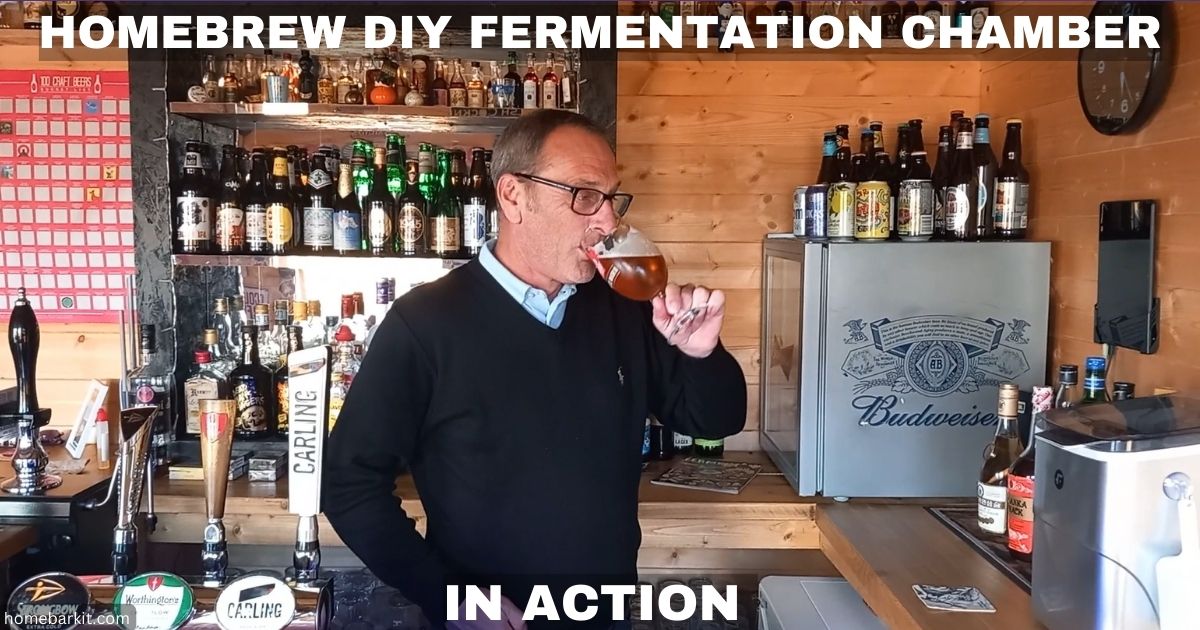If you like to brew beer at home, then one of the main things to make sure your beer turns out well is temperature control. It is hard to keep your beer at the right temperature for a successful brew without expensive equipment.
Unless of course you set up your own DIY Fermentation Chamber. Which may sound hard, but it’s pretty easy really.
To set up your own DIY fermentation chamber there are only a few things you will need. A fridge, a small tube heater and a thermostat temperature control unit. The temperature control unit will keep the fermentation chamber (fridge) at the temperature you set it to. Which means your beer will be at the right temperature during the fermentation process.
Table Of Contents
- Fridge Conversion
- Heater
- Temperature Control Unit
- Homebrew DIY Fermentation Chamber In Action
- Final Thoughts
Fridge Conversion
To buy a purpose built fermentation chamber is pretty expensive, so many people, including myself have converted a standard fridge into our own fermentation chamber. And you can do it for around a hundred quid.
Please Note: I am not recommending in any way that you should convert a fridge into a fermentation unit.
The reason I do not recommend you convert a fridge into a fermentation unit is because it involves drilling a hole or holes in the side or door of the fridge to feed the cables or beer lines through. There are pipes running along the walls of a fridge and you do not want to drill through one of them.
If you decide to go ahead with converting a fridge into a fermentation chamber, then do be very careful and make sure you do not hit any pipes that might be within the fridge walls.
I personally drilled from the inside out, by drilling a hole in the plastic mold first. It is easy to drill just the plastic mold without going all the way through the insulation and outer fridge wall.
Once you have a hole in the mold you can carefully scrap out the insulation with a small screwdriver and reveal whether there are any obstructions to the outer wall. If there are no pipes and you can clearly see the outer wall, then it is safe to drill through.
This is how I safely drilled two holes in each side of a fridge, but again I do not recommend it.
I have two drilled holes, one for the heater cable and temperature probe, and the other for my beer line. But that is because I use mine as a fermentation chamber when brewing, as well as a fridge when serving my homebrew.
So for just a fermentation chamber, one hole is probably okay.
Having said all that, I have seen others just use the seal of the fridge door to put the heater cable and thermostat probe through. Because the door seal is soft with some give it is possible to use it for the cable entries. It does work as I tried it, but I am a neat freak and didn’t like the cables arranged in this way.
But it is an option and it saves getting the drill out.
Obviously you need to take out the shelves and salad draw from the fridge, so as to fit the fermentation bucket in.
Also it is best to get a fridge without the freezer compartment at the top, as this will get in the way of the fermentation bucket.
Finally on the fridge, to keep things cheap it is best to get a secondhand fridge, mine cost me £40.
Heater
The heater is to bring the temperature of the beer up if it drops below your set temperature. I use a simple tube heater that sits in the bottom of the fridge and it is enough to heat such a small area.
These type of heaters are used for greenhouses, garages and small areas that need to be kept warm.
“As an Amazon Associate I earn from qualifying purchases.”
Mine is a Dimplex Tube Heater and cost me £20 and is 1ft long or around 300mm, so fits easily into the fridge, and it works perfectly.
Temperature Control Unit
The temperature control unit is to keep your beer at the desired temperature. It has a digital display with two cables. One cable leads to a two plug socket, one for the fridge and the other for the heater. The other cable is the heat sensor probe that sits inside the fridge.
You plug the heater into its socket and the fridge into its socket. The temperature control unit is then plugged into a wall socket.
You then set your desired temperature with a lower temperature and a higher temperature. So I set mine to 21°C, then I set the lower and higher temperature 1 degree either way.
This makes sure the fridge and heater are not kicking in constantly, which wouldn’t be good for either.
I found that initially the temperature was a bit up and down, but within an hour it had stabilised. And maintained my set temperature of 21°C.
“As an Amazon Associate I earn from qualifying purchases.”
The temperature control unit I use is the Inkbird ITC308 which is the WIFI version, so I can control the unit from my phone. It cost me £45, but the none WIFI version is around £35, so a bit cheaper.
Homebrew DIY Fermentation Chamber In Action
As you can see from the video the whole set up is pretty simple and works really well. It kept my homebrew beer at the right temperature throughout its primary fermentation, with just 1°C maximum fluctuation in temperature.
A far better system than a heat pad or blanket in my opinion. It is almost a set and forget fermentation system, although there is nothing wrong with checking your phone to see what temperature it is at from time to time.
Final Thoughts
I am really pleased with how my fermentation chamber has worked for my homebrew. And the best thing is because I have a beer line and tap set up, when my beer is ready I can switch it back to a fridge and enjoy my beer on draught in my pub shed.
It is an investment, but a reasonable one, my fermentation chamber set up cost me £105, but I could have done it for £95 if I had gone for the standard Inkbird and not the WIFI version. You may also be able to pick up a fridge for less than £40.
Confession: The £40 fridge was my second attempt at a DIY fermentation chamber. My first attempt involved a fridge I got for £15 and drilling through a pipe in the side wall. I drilled a hole from the outside in and hit a pipe, so the fridge became useless. This is why on my second attempt I drilled through the inside plastic wall first to investigate for pipes before drilling right through, you learn by your mistakes.
Remember I don’t recommend drilling through the wall of a fridge. But if you do, then be warned, and be careful.
Happy Brewing!
Rob is a passionate home bar and pub shed enthusiast with a passion for craft beer. With hands-on experience in designing and building his own home bar, Rob shares his knowledge, tips, and inspiration to help fellow enthusiasts create their own perfect space. Alongside the world of home bars and pub sheds, Rob also explores the diverse and exciting realm of craft beer, providing honest reviews to help you discover your next favorite brew. Join Rob on a journey of flavor, design, and craftsmanship right here on Home Bar Kit.

